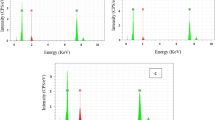Abstract
The protection against the corrosion of the carbon steel in aqueous environment by commercial inhibitors, based of nitrite and alkanolamine, has been studied by electrochemical impedance spectroscopy (EIS) and several analytic methods. An inhibitor’s efficiency has been determined with the two compounds on polished surface in presence of softened water. The results show that the two inhibitors act by the formation of protective layer on interface steel/electrolyte but the efficiency is more important in the case of the nitrite compound thanks to the formation of film with thickness estimated by Atomic force microscopy (AFM) at 0.8 μm after 102 days of immersion. In the case of the nitrites, the inhibitor film is a porous layer, weak conductor and presents a considerable increase of the charge transfer resistance with time. This is a result of an interest protection of the surface against corrosion. The low frequencies limit (L LF) reaches about 150 kOhm cm2 after 59 days of immersion. In the case of the alkanolamine, XPS (X-Rray Spectroscopy) show that the film formed is richer of Fe ions but is offered a considerable protection of the interface, its thickness is about 0.26 μm and L LF reaches about 35.5 kOhm cm2 after 61 days of immersion. The influence of surface state is discussed in this paper, in fact on raw surface steel, no inhibitor efficiency is observed. A few protections are given with a crude surface in contact with water softened in presence of the nitrite compound.
Similar content being viewed by others
References
Rozenfold, I.L., Corrosion Inhibitors Ed Mc Graw-Hill International Book Company, 1982.
Akrout, H., Bousselmi, L., Triki, E., Maximovitch, S., and Dalard, F., Effect of Non-toxic Corrosion Inhibitors on Steel in Chloride Solution, Journal of Materials Science, 2004, vol. 39, pp. 7341–7352.
Akrout, H., Bousselmi, L., Triki, E., Maximovitch, S., and Dalard, F., Adsorption Mechanism of Non-toxic Organic Inhibitors on Steel in Solutions at pH 8 Determined by Electrochemical Quartz Crystal Microbalance Measurements, Materials and Corrosion, 2005, no. 3, 5, pp. 185–189.
Frignani, A., Monticelli, C., and Trabanelli, G., Tryptamine as a Green Corrosion Inhibitor in 0.5 Desecrated Sulphuric Acid, Proc. 9th European Symposium on Corrosion Inhibitors, Ann. Univ. Ferrara, N.S. Sez. V, 2000, suppl. no. 11, pp. 749–759.
Kawai, T., Nishihara, H., and Aramaki, K., Corrosion of Iron in Electrolytic Anhydrous Methanol Solutions Containing Ferric Chloride, Corrosion Science, 1995, vol. 37, pp. 823–831.
Ochoa, N., Baril, G., Moran, F., and Pébère, N., Study Effect of the Properties of a Muti-component Inhibitor Used for Water Treatment in Cooling Circuits, Journal of Applied Electrochemistry, 2002, vol. 34, pp. 497–504.
Kodama, H., Infrared Spectra of Mineral, Edition Research Branch Agriculture Canada, Technical Bulletin-1E, 1985, vol. 1.
Avran, M., Mteescu, Ch., Infrared Spectroscopy, Wiley Interscience, 1996.
Bellamy, L.J., The Infrared Spectra of Complex Molecules, 3rd ed. Chapman Andhall, 1975, vol. 1.
Bousselmi, L., Etude Analytique et électrochimique de l’interface Acier Ordinaire-eau de la Nappe du Complexe Terminal: Contribution des Méthodes Transitoires, Thèse de Doctorat de la faculté des Sciences de Tunis, 1995.
Bousselmi, L., Fiaud, C., Tribollet, B., and Triki, E., Impedance Spectroscopic Study of Steel Electrode in Condition of Scaling and Corrosion Interphase Model, Electrochimica Acta, 1999, pp. 4357–4363.
Kern, P. and Landolt, D., Adsorption of Bromine Labeled Carboxylic Acid Inhibitor on Iron Measured with EQCM, EIS and XPS, Corrosion Science, 2002, no. 44, pp. 1809–1824.
Tink, T.A., Pébère, N., Hang, T.T.X., and Hervaud, Y., Study of the Synergistic Effect Observed for the Corrosion Protection of a Carbon Steel, Corrosion Science, 2002, vol. 44, pp. 2055–2071.
To, X.H., Pébère, N., Pelaprat, N., and Boutevin, B., Corrosion-Protective Film Formed on a Carbon Steel by an Organic Phosphonate, Corrosion Science, 1997, no. 39, pp. 1925–1934.
Pébère, N., Picaud, T.H., Duprat, M., and Dabosi, F., Evaluation of Corrosion Performance of Coated Steel by the Impedance Technique, Corrosion Science, 1989, no. 29, pp. 1073–1086.
Brug, G.J., Van Den Eeden, A.L.G., Slyters-Rehbach, M., and Slyters, J.H., The Analysis of Electrode Impedance Complicated by the Presence of the Constant Phase Element, Journal of Analytical Chemistry, 1984, vol. 176, pp. 275–295.
Author information
Authors and Affiliations
Corresponding author
Additional information
The article is published in the original.
About this article
Cite this article
Akrout, H., Bousselmi, L. & Triki, E. The inhibition effect of two commercial compounds on interface steel/natural softened water. Surf. Engin. Appl.Electrochem. 46, 452–461 (2010). https://doi.org/10.3103/S1068375510050091
Received:
Published:
Issue Date:
DOI: https://doi.org/10.3103/S1068375510050091




